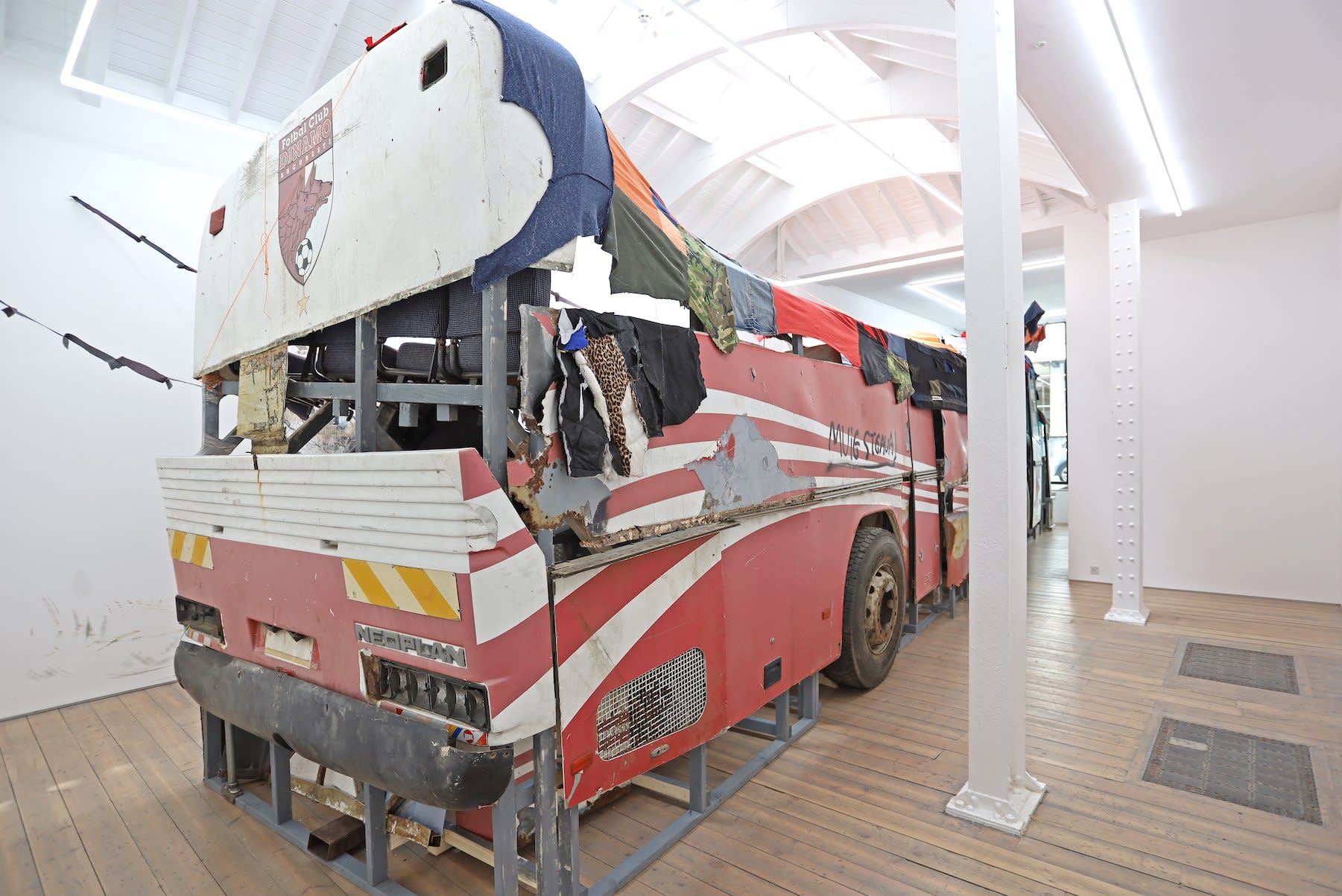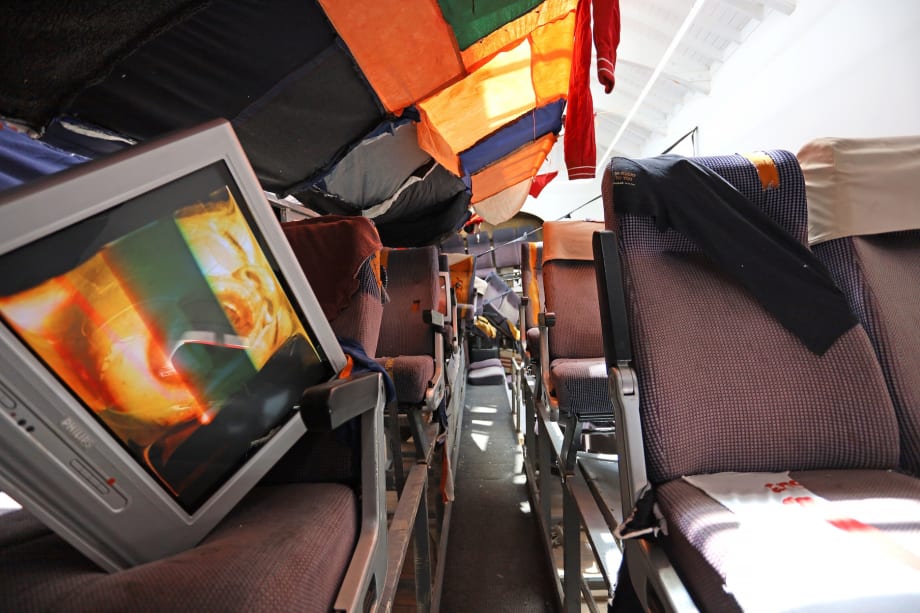18 July 2023 NEOPLAN, the sixth Marcin Dudek's exhibition at Edel Assanti in London - an autobiographical journey within the context of hooliganism, memory, and personal recollection.
From May 31st to September 1st, Edel Assanti presents NEOPLAN, showcasing the body of work of the Polish artist Marcin Dudek. NEOPLAN expands on Marcin Dudek's urgency of creating memory boxes, lost sites specific to his experience embedded in cultural artifacts. The installation and the collages embody fragments of arenas, tickets, banners, and other ephemera that constitute Dudek's ongoing research archive dedicated to the subculture that obsessed him during his teenage years as a supporting member of a violent Krakow football team Fanclub.
Marcin Dudek, NEOPLAN: coordinates
Within the form of an extended visual essay, the exhibition unfolds its existence through multiple and intertwining layers of discourse. At the liminal intersections between the private and the public, navigating the line between personal recollections and collective identity, NEOPLAN explores the transformative potentialities of the politics of memory within the context of the idea of the spectacle in the stadium and beyond.
Marcin Dudek's spatial and temporal surroundings
From situated regionality to situated regionality, political landscapes connote the visible field, determining what can be seen and what is unseen. In other words, heterogeneous cultural contexts shape how things fall on the spectrum of visuality, rendering certain things noticeable while others remain under-visualized or not visualized.
The specificity of Marcin Dudek's immediate spatial and temporal surroundings resonates throughout the work. The monolithic representation of the realm within the context of Soviet influence determined extensive implications in the trajectories the Polish artist traced in his exploratory archaeological process.
Marcin Dudek - from Soviet to Western influences
«There was censorship in Poland and no access to the free media. So, we have confronted just selected features of Soviet bloc reality. And as a child or young person, you are faced with something restricted, and the consciousness already questions what is behind and beyond this control. Being a subject to this was already instigating anger and interrogating the mind. What is behind it? This state of mind has been formed since my early childhood.
In the nineties, everything broke through all this. A tsunami of information flooded into it. We have suddenly been confronted with massive amounts of radio and television data», the artist accurately expands.
«So just imagine as a young person how fragile you are between all these transition moments, how confusing it is. What do I have to trust? Who is saying the right thing? What is true?
The first Western TV I was confronted with was Rai Uno. I can remember it as it was today; everything was crystal clear and colorful, in contrast to the schematic reality depicted by the local media. This incredible reality was just outside the box, graspable and ungraspable at once», Dudek illustrates.
Marcin Dudek's research culminates in navigating remote futurity
According to French philosopher Jacques Derrida, memory is transient, impermanent, and perpetually subject to negotiation between social discourses and power structure.
Orientated by autobiographical archaeology, Marcin Dudek's research culminates in navigating remote futurity. By interrogating the traces, new tactility is bestowed on the memory; by rejecting the fixity of the familiar, a new skin of things emerges.
Transcending the solid corporeality of its constitution, the artifact originates from a porous intangible membrane. Indeed, the transitory fragment extracted from remembrance floods to the surface through a twofold and diametrically opposed movement of dismantling and restructuring. The dissection of the memory coincides with the secretion of the memory box, the memory boxes with chambers of reflection.
Along this cyclical progression, the artwork shifts away from strict temporalities, oscillating between the indefinite past and the not-yet-here. Rejecting any logocentric modes of discursiveness, the memory box claims its belonging to fragmentariness and non-linearity.

Marcin Dudek: NEOPLAN, installation view, Edel Assanti, London, 2023.
Marcin Dudek, NEOPLAN at Edel Assanti, London - psychology of crowd dinamics
By depicting the migration to the crowd, we envisage the subjectivity dissipating into this formless and opaque substance. Conversely, conceiving it as a center of force and resistance to the separate, radicalized, qualitatively measurable individual is possible. Crowd transcends mere subjectivity, aggregating an extra dimensionality to the flattened surface of the self.
«Only together men can eliminate their distances: that is what happens in the mass. In that density, each is as close to the other as to himself», Elias Canetti wrote in Crowd and Power.
Marcin Dudek embraced the hooligan subculture during the Nineties in Krakow
During the exhibition opening, the urgency of this density and the need to regenerate the sense of plurality within the gallery setting prompted the artist to ignite an orange smoke grenade, typically associated with the hooligan subculture he embraced during the nineties in Krakow.
«Lighting the smoke grenade filled the space, and I felt like I was multiplying the individual. The crowd was being manifested by the fumes. Disorientating and losing the sense of direction, I also almost lost control of my individual body. It activated the perception of the riot; the individual became multiple. The crowd always exists within the individual that belonged to it; as a sort of genetic memory, like a seed planted within the self», Marcin Dudek says.
After its activation, the artist traversed the perimeter of the space, tracing irregular lines with the residual pigments from the combustion, imprinting permanent traces on exposed artworks.
Marcin Dudek, NEOPLAN - Notes on the architectural apparatus within the arena
Canetti presents the concept of the crowd as a ring. The enclosed arena becomes a place where the spectators turn their backs to the reality of the city and levitate in the ecstasy of the spectacle, consuming the mass euphoria of the entire arena.
Architectural barriers and confinements regulate the flux into and out of the arena; the current system of partitioning it into boxes and sectors corresponds to specific socio-economic functions.
The boundary is not a non-place between two places, a mere tactile line between what resides before and after; the limit exists as a place and has specific performativity: turnstiles, grates, gates, and barricades are not silent but politically and symbolically connotated objects.
«The turnstile is the symbolic moment of institutionalizing the mass. You cross the turnstile and become part of an organized institutional space; it is a moment of transformation, entering the circle as an individual and coming out on the other side as part of something larger, the crowd. They are places in-between; barriers are there to confront us, to put us in question; they have a symbolic function», concludes the artist.



